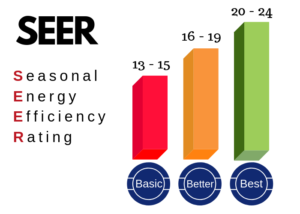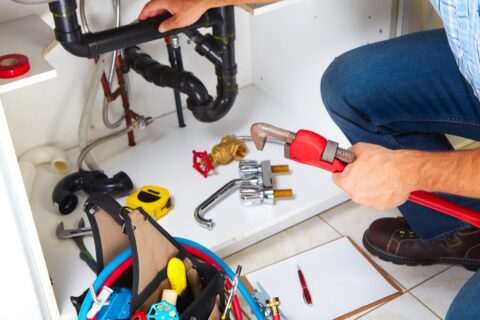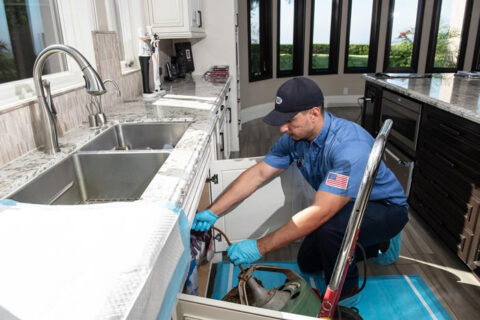Understanding AC Efficiency Ratings Explained
Understanding AC efficiency ratings decoded can save you money and energy. These ratings help you choose the right air conditioning system for your needs. They indicate how effectively an AC unit cools your space while consuming less power. Higher ratings for the furnace mean better efficiency, leading to lower utility bills.
Decoding these ratings isn’t just for techies; it’s for anyone looking to make smart choices about air conditioning efficiency. Knowing what these numbers mean empowers you to select the best option for comfort and savings. This post will break down the key terms and concepts behind AC efficiency ratings, helping you navigate your options confidently. Get ready to unlock the secrets of efficient cooling!
Key Takeaways
-
Understanding AC efficiency ratings helps you choose the right system for your home, ensuring comfort and lower energy bills.
-
Familiarize yourself with different rating systems like EER and SEER to make informed decisions when purchasing an air conditioner.
-
Look for units with high Seasonal Energy Efficiency Ratings (SEER) as they indicate better performance over the cooling season.
-
The Heating Seasonal Performance Factor (HSPF) is crucial for heat pumps; higher ratings mean more efficient heating.
-
Prioritize high efficiency ratings when shopping for AC units, as they can lead to significant long-term savings on energy costs.
-
Consider factors such as climate, unit size, and installation quality that can affect overall AC efficiency and performance.
Understanding AC Efficiency Ratings
Purpose of Ratings
Efficiency ratings measure how well an air conditioner converts energy into cooling. These ratings indicate how much electricity the unit uses compared to the cooling it provides. A higher rating means better energy conversion and less wasted electricity.
The most common efficiency rating is the Seasonal Energy Efficiency Ratio (SEER). This number represents the cooling output during a typical cooling season divided by the total energy consumed in watt-hours. For example, an AC unit with a SEER of 16 provides 16 BTUs of cooling for every watt-hour used.
Impact on Consumption
Efficiency ratings significantly affect energy consumption. Higher-rated units consume less electricity for the same amount of cooling. This translates to lower utility bills over time. For instance, switching from a SEER 10 unit to a SEER 16 can save homeowners hundreds of dollars annually.
Energy efficiency also contributes to environmental benefits. Lower energy use means reduced greenhouse gas emissions. This is crucial as many power plants still rely on fossil fuels. Choosing an efficient air conditioner can help reduce your carbon footprint.
Cost Savings
Cost savings arise not only from lower monthly bills but also from potential rebates and tax incentives. Many utility companies offer programs that reward customers for purchasing high-efficiency units. Some governments provide tax credits for energy-efficient appliances, making them more affordable.
Investing in a high-efficiency air conditioner may have a higher upfront cost. However, the long-term savings often outweigh this initial expense. Homeowners should calculate their expected savings based on local electricity rates and usage patterns before purchasing.
Informed Decisions
Understanding AC efficiency ratings is essential for smart buying decisions. Consumers should compare different models based on their SEER ratings. This helps identify which unit offers the best value over its lifetime.
Other factors also matter when selecting an air conditioner. Consider the size of your home and specific cooling needs. An oversized unit may cool too quickly, causing it to cycle on and off frequently, which reduces efficiency.
Homeowners should also look at additional features like variable-speed compressors and smart thermostats. These features can further improve efficiency by adjusting power use based on demand.
Overview of Rating Systems
EER System
EER stands for Energy Efficiency Ratio. This rating measures how efficiently an air conditioning unit operates when it is running at full capacity. The formula for EER is the cooling output in BTUs per hour divided by the power input in watts.
For example, if an AC unit has a cooling output of 12,000 BTUs and uses 1,200 watts, its EER would be 10. This means it produces ten BTUs for every watt consumed. A higher EER indicates better efficiency.
SEER Rating
SEER refers to Seasonal Energy Efficiency Ratio. Unlike EER, SEER evaluates efficiency over an entire cooling season. It considers variations in temperature and humidity.
To calculate SEER, you divide the total cooling output during the season by the total energy consumed. For instance, if an air conditioner provides 36,000 BTUs over a cooling season while using 3,600 watts, its SEER would be 10. A higher SEER rating signifies improved efficiency and lower energy costs.
HSPF Value
HSPF stands for Heating Season Performance Factor. It measures the efficiency of heat pumps during the heating season. Like SEER, HSPF takes into account the total heating output compared to energy consumed.
The formula is similar: divide the total heating output in BTUs by the total energy used in watts. For example, if a heat pump generates 24,000 BTUs while consuming 2,400 watts over a season, its HSPF would also be 10. Higher HSPF values indicate more efficient heating performance.
Importance of Ratings
Each rating system plays a crucial role in evaluating HVAC performance. EER provides insight into how well a unit performs under peak conditions. It helps consumers understand immediate performance but does not account for seasonal variations.
SEER offers a broader perspective on efficiency throughout the cooling season. Consumers can use this information to estimate long-term energy savings. A unit with a high SEER rating can lead to significant cost reductions.
HSPF is vital for those using heat pumps for heating. Understanding HSPF helps consumers choose units that provide efficient heating during colder months.
Energy Efficiency Ratio Explained
EER Calculation
Energy efficiency ratio (EER) measures how effectively an air conditioning system cools a space. It calculates the cooling output in British Thermal Units (BTUs) per hour divided by the electricity consumed in watts.
For example, if an air conditioner provides 10,000 BTUs of cooling and uses 1,200 watts, the EER would be calculated as follows: 10,000 BTUs ÷ 1,200 watts = 8.33 EER. This number indicates how efficient the unit is at converting electricity into cooling power.
Average EER Ratings
Room and portable air conditioners vary in their energy efficiency ratings. The average EER for room air conditioners typically ranges from 8 to 12. Portable units usually have slightly lower ratings, averaging between 6 to 10. Higher-rated units often provide better performance with lower energy consumption.
A higher EER means more cooling for less electricity used. This translates to potential savings on monthly utility bills. Selecting a unit with an EER of 10 or above can greatly reduce energy costs over time.

Cost Benefits of Higher EER Units
Choosing air conditioning systems with higher EER ratings can lead to significant cost benefits. While these units may have a higher upfront price, they save money in the long run through reduced energy consumption.
For instance, consider a home using an air conditioner with an EER of 8 versus one with an EER of 12. If both units operate for 1,000 hours a year, the unit with an EER of 8 would consume about 1250 kWh, while the one with an EER of 12 would use around 833 kWh. This results in savings of approximately $50 to $100 annually on electric bills, depending on local rates.
Investing in high-efficiency units also contributes to environmental sustainability. Lower energy use means fewer greenhouse gas emissions from power plants.
Energy Efficiency Options
Homeowners should explore various energy efficiency options when selecting air conditioning systems. Look for ENERGY STAR® certified models for guaranteed performance and efficiency. These models meet strict guidelines set by the U.S. Environmental Protection Agency.
Consider integrating smart technology into your cooling system as well. Smart thermostats can optimize energy use based on your schedule and preferences.
Seasonal Energy Efficiency Rating
Definition
Seasonal Energy Efficiency Rating (SEER) measures the efficiency of HVAC systems over a typical cooling season. This rating considers seasonal temperature variations. It calculates how much cooling a system provides compared to the electrical energy it consumes.
Importance of SEER
SEER accounts for changes in temperature throughout the year. It reflects real-world performance, unlike other ratings that might only show efficiency under specific conditions. A higher SEER score indicates better energy efficiency. This means lower energy bills and improved comfort during hot days.
Good SEER Scores
A good SEER score varies by system type. For central air conditioning units, a SEER score of 14 or higher is generally considered efficient. Many modern systems reach scores between 16 and 20. Heat pumps also benefit from high SEER ratings, especially in milder climates.
For example, an HVAC system with a SEER score of 18 uses less energy than one with a score of 12. The difference can be significant over time. Homeowners can save hundreds of dollars on their electricity bills.
Consulting Professionals
Determining the optimal SEER for individual homes requires professional input. HVAC technicians consider several factors. They assess home size, insulation quality, and local climate conditions.
Consulting professionals ensures homeowners select systems best suited to their needs. They can provide an HVAC energy efficiency rating infographic to help visualize options. This tool simplifies understanding different models and their efficiencies.
Minimum SEER Requirements
Minimum SEER requirements vary by region and equipment type. In the U.S., the Department of Energy sets standards for new systems. Currently, most regions require a minimum SEER of 14 for residential air conditioners.
Homeowners should check local regulations before purchasing a new unit. Meeting or exceeding the minimum SEER is crucial for long-term savings and comfort.
Benefits of High SEER Ratings
Investing in a high-efficiency system offers multiple benefits:
-
Lower energy costs
-
Increased comfort levels
-
Reduced environmental impact
These benefits make high SEER ratings appealing to homeowners looking for sustainable options.
Heating Seasonal Performance Factor
Function of HSPF
The Heating Seasonal Performance Factor (HSPF) measures the efficiency of heat pumps. It evaluates how well a heat pump performs over an entire heating season. This metric considers both the heating output and energy consumption. A higher HSPF indicates better efficiency.
HSPF combines the total heating output in BTUs with the total energy used in kWh. This ratio helps consumers understand how effectively a heat pump converts electricity into heat. For example, if a heat pump produces 10,000 BTUs while using 1,000 kWh, its HSPF is 10. This means it delivers 10 BTUs for every kWh consumed.
BTUs and kWh Relationship
In the HSPF calculation, the relationship between BTUs produced and kWh used is crucial. BTUs measure heating output, while kWh represents electrical energy consumption. To calculate HSPF, divide the total BTUs produced by the total kWh used.
For instance, if a heat pump generates 30,000 BTUs during the season but consumes 3,000 kWh of energy, the calculation would be:
30,000 BTUs ÷ 3,000 kWh = 10 HSPF.
This result shows that for each unit of energy consumed, the heat pump provides ten units of heating.
Availability of High HSPF Heat Pumps
Many manufacturers offer heat pumps with high HSPF ratings. These models are designed to maximize efficiency and minimize energy costs. High HSPF ratings often indicate better performance in colder temperatures.
Consumers can find models with HSPF ratings ranging from 7 to over 10. Units with ratings above 9 are considered excellent choices for efficiency. Investing in a high HSPF heat pump can lead to significant savings on energy bills. These systems often qualify for rebates or incentives due to their efficiency.
Choosing a heat pump with a high HSPF rating ensures comfort during winter months. It also supports environmental goals by reducing overall energy usage.
Importance of High Efficiency Ratings
Financial Benefits
Investing in high efficiency ratings for air conditioners can lead to significant long-term savings. These systems consume less energy, which translates to lower utility bills. For instance, a system with a higher efficiency rating can save homeowners hundreds of dollars annually. Over time, the initial investment pays off through these savings.
High-efficiency HVAC systems often qualify for rebates and tax credits. Many utility companies offer incentives for installing energy-efficient models. This can further reduce the overall cost. Homeowners should consider these financial benefits when selecting an HVAC system.
Environmental Impact
Lower energy consumption from efficient HVAC systems also benefits the environment. Reduced energy use means fewer fossil fuels are burned. This leads to lower greenhouse gas emissions. In 2020, buildings accounted for about 39% of carbon dioxide emissions in the U.S. Choosing efficient heating options helps combat climate change.
Efficient energy usage contributes to cleaner air and a healthier planet. Less energy consumption reduces the demand on power plants. This results in fewer pollutants being released into the atmosphere. By prioritizing efficiency ratings, consumers play a role in promoting sustainability.
Selecting Efficient Systems
Consumers should prioritize efficiency ratings when choosing HVAC systems. The most common efficiency rating measures include SEER (Seasonal Energy Efficiency Ratio) for cooling and AFUE (Annual Fuel Utilization Efficiency) for heating. Understanding these ratings helps consumers make informed decisions.
New HVAC systems often come with improved efficiency ratings compared to older models. Homeowners should look for units that meet or exceed the minimum efficiency ratings set by regulatory bodies. These standards ensure that systems provide adequate performance while minimizing energy use.
Key Considerations
-
Research different efficiency ratings before making a purchase.
-
Evaluate your home’s specific needs to determine the ideal HVAC system.
-
Consult professionals to understand how BTU requirements affect efficiency.
Taking these steps ensures you choose an efficient HVAC system tailored to your situation.
How to Interpret Energy Ratings
Understanding Ratings
Energy ratings can seem confusing. Different systems use various scales and metrics. The most common ratings include SEER, EER, and HSPF.
SEER stands for Seasonal Energy Efficiency Ratio. It measures cooling efficiency over a season. A higher SEER means better energy savings.
EER, or Energy Efficiency Ratio, measures efficiency at peak conditions. It is useful for understanding performance in hotter climates.
HSPF refers to Heating Seasonal Performance Factor. This rating applies to heat pumps. Like SEER, a higher number indicates better efficiency.
Comparing Ratings
Comparing different ratings requires attention to detail. Start with the type of system you need. If you live in a warm area, focus on SEER ratings. For heating needs, look at HSPF values.
Check the manufacturer’s specifications when comparing products. They often provide detailed information about the ratings.
For example, if two air conditioners have similar SEER ratings but differ in price, consider their warranty and reliability too.
Finding Relevant Ratings
Identifying the most relevant rating depends on your specific needs. If you want to lower electricity bills, prioritize higher SEER or EER ratings.
Consider your local climate as well. In regions with extreme temperatures, systems with higher ratings perform better overall.
Also think about the size of your space. An oversized unit may not operate efficiently despite high ratings.
Resources for Assistance
Several resources help decode energy ratings further. The U.S. Department of Energy offers guidelines on understanding these metrics. Their website includes calculators for estimating potential savings based on efficiency ratings.
Local utility companies often provide tools and incentives for energy-efficient upgrades. They might have programs that highlight efficient models available in your area.
Consulting an HVAC professional can also clarify which systems best fit your needs. They can assess your home and recommend suitable options based on efficiency ratings.
Factors Affecting AC Efficiency
Installation Quality
Installation quality significantly impacts air conditioning efficiency. A poorly installed air conditioning unit can lead to energy loss. Gaps in ductwork or incorrect sizing of the system can cause inefficiencies. Proper installation ensures that the system operates as intended. It is crucial to hire qualified professionals for installation. They will follow guidelines and best practices, leading to an efficient air conditioner.
Regular maintenance also plays a role in maintaining efficiency. Neglected systems may struggle to perform optimally. Dirty filters and coils can block airflow, forcing the unit to work harder. This increases energy consumption and reduces overall performance. Homeowners should schedule routine check-ups with residential air conditioning services. This step helps keep the system running efficiently.
Climate Influence
Climate directly affects air conditioning energy efficiency. Hotter climates require more cooling power from air conditioners. In these areas, efficient air conditioning solutions become essential. Systems may need to run longer hours, increasing energy use. Choosing an energy-efficient model is vital for homeowners in warm regions.
Conversely, cooler climates may not require constant cooling. Homeowners can opt for less powerful units, which consume less energy. Understanding local climate conditions helps in selecting the right air conditioning systems.
Home Insulation
Home insulation significantly impacts the performance of air conditioning units. Well-insulated homes retain cool air better than poorly insulated ones. This means the air conditioner does not have to work as hard to maintain comfortable temperatures. Insulation prevents heat from entering during hot months.
Homeowners should assess their insulation levels regularly. Upgrading insulation can lead to substantial savings on energy bills. Sealing windows and doors also enhances efficiency by reducing drafts.
System Type
The type of air conditioning system influences its efficiency rating. Central air conditioning systems typically provide better efficiency for larger spaces compared to room air conditioners. Portable air conditioners are convenient but may not be as efficient for whole-house cooling.
New air conditioners often feature advanced technology that boosts efficiency ratings. Look for models with high SEER (Seasonal Energy Efficiency Ratio) ratings when purchasing a new unit. Higher SEER ratings indicate better energy performance over time.
Maintenance Practices
Regular maintenance practices ensure optimal performance of air conditioning systems. Changing filters every 1-3 months improves airflow and efficiency. Cleaning coils and checking refrigerant levels are also essential tasks.
Homeowners should familiarize themselves with basic maintenance practices. This knowledge leads to better decision-making regarding HVAC decisions in the long run.
Closing Thoughts
Decoding AC efficiency ratings is essential for making informed choices. You’ve learned how various rating systems like EER, SEER, and HSPF impact your energy bills and comfort. High efficiency ratings mean savings and a smaller carbon footprint, so prioritize these when shopping for your next unit.
Understanding these ratings empowers you to choose wisely. Don’t just settle for any air conditioner—opt for one that fits your needs and boosts your energy efficiency. Check those ratings before buying! Now that you’re equipped with this knowledge, take action. Research your options and make the best decision for your home and wallet.
Frequently Asked Questions
What do AC efficiency ratings indicate?
AC efficiency ratings measure how effectively an air conditioning unit converts electricity into cooling. Higher ratings signify better performance and lower energy costs.
What is the Energy Efficiency Ratio (EER)?
The Energy Efficiency Ratio (EER) calculates cooling output per watt of electricity consumed. A higher EER means more efficient energy use, leading to cost savings.
What is the Seasonal Energy Efficiency Ratio (SEER)?
The Seasonal Energy Efficiency Ratio (SEER) measures an AC’s cooling efficiency over an entire season. It considers varying temperatures, making it a reliable indicator for consumers.
How does the Heating Seasonal Performance Factor (HSPF) work?
The Heating Seasonal Performance Factor (HSPF) evaluates heat pump efficiency during the heating season. A higher HSPF indicates better performance and lower heating costs.
Why are high efficiency ratings important?
High efficiency ratings lead to reduced energy consumption and lower utility bills. They also minimize environmental impact, making them a smart choice for eco-conscious consumers.
How can I interpret AC energy ratings?
To interpret AC energy ratings, compare EER and SEER values. Higher numbers mean better efficiency. Always consider your local climate when selecting an appropriate rating.
What factors affect AC efficiency?
Factors affecting AC efficiency include unit size, installation quality, maintenance, and local climate conditions. Proper care and installation can significantly enhance performance.


